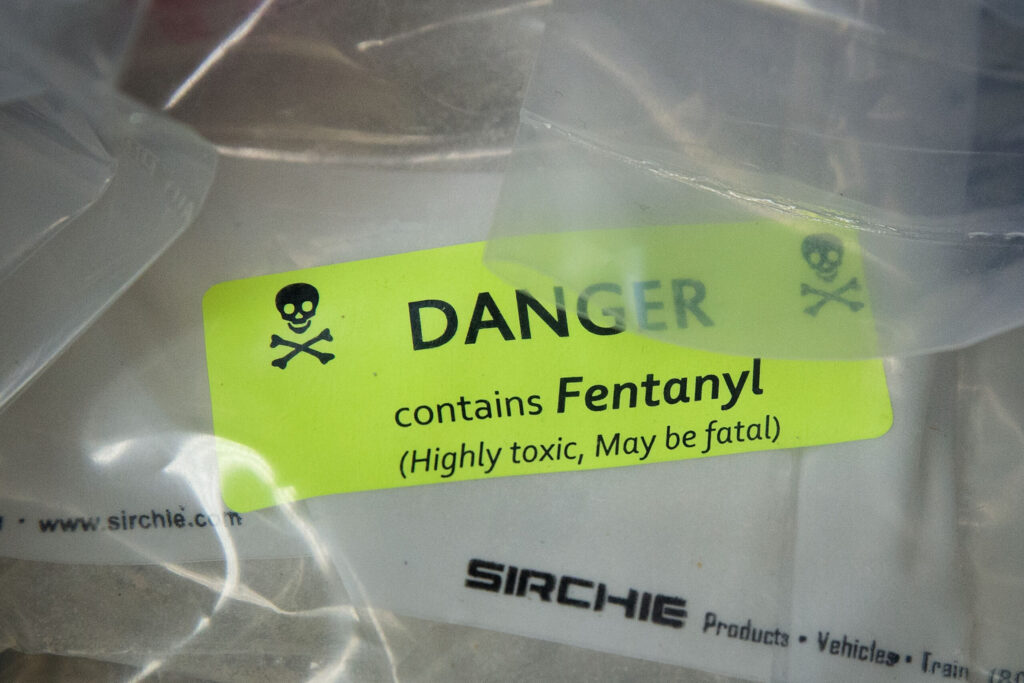Bags of heroin, some laced with fentanyl, are displayed before a press conference regarding a major drug bust, at the office of the New York Attorney General, Sept. 23, 2016 in New York City. (Drew Angerer | Getty Images)
Annual drug overdose deaths in West Virginia appear to be continuing to slow after a 2020 spike, according to preliminary data from the state’s Office of the Chief Medical Examiner.
According to the data — which is subject to change as more information is released — at least 1,383 people fatally overdosed in West Virginia in 2023, which is about 77 overdoses per 100,000 people. That’s nearly a 2% decrease from 2022 but still more than double the national rate, according to the Centers for Disease Control and Prevention.
It’s the second consecutive year with a decline — albeit small — in the total number of fatal overdoses in the state.
The overdose data is compiled from causes of death reported on death certificates certified by the Office of the Chief Medical Officer and are not final, meaning numbers could rise as more death certificates are analyzed.
Many overdose deaths include more than one drug, and, while total overdose death numbers are not duplicative, the data set lists any drug contributing to the death, according to the state.
Prior to 2020, overdose deaths in West Virginia peaked in 2017, breaking 1,000 for the first time as 1,019 residents reportedly died that year. More than 85% of overdoses that year included an opioid. Rates declined in both 2018 and 2019.
But when the pandemic came, overdose rates rose alongside it, hitting a new record as 1,343 people died from overdoses in 2020. That increase continued into 2021, as 1,537 people died.
For 2023, McDowell County led the state again in the number of fatal overdoses per capita, with 183 fatalities recorded per 100,000 people. It was followed by Cabell County (with 174 fatal overdoses per capita), Mercer County (153 fatal overdoses per capita), Raleigh County (152 fatal overdoses per capita) and Wyoming County (122 fatal overdoses per capita).
Only two counties, Tyler and Gilmer, have so far reported no overdose deaths for 2023. In both 2023 and 2022, 26 West Virginia counties saw declines in the rates of fatal overdoses, per the data.
While the number of overdoses is trending down, the percentage involving opioids has remained high, at about 86% in 2023, compared to about 85% in 2022. That rate hit its lowest in 2019, when just 76% of fatal overdoses in the state involved an opioid.
Before 2022, 2019 was the last year to see a decrease in the number of fatal overdoses in the state.
Between then and 2023, Mercer County has reported the largest percentage increase in fatal overdoses over the five year period (314% more). It was followed by McDowell County (289% increase), Wyoming County (225% increase), Greenbrier County (190% increase) and Preston County (167% increase).
The number of fatal overdoses involving heroin is so far the lowest it’s been in 20 years, according to the data, with just eight reported to date in 2023. That’s about a 73% drop from the 30 reported in 2022. No county in 2023 reported more than four overdoses involving heroin.
The last time that number dropped so low was in 2003, when there were five recorded. Heroin overdoses in the state peaked in 2017, with 268.
Fatal overdoses involving fentanyl are still high in the state, with 1,126 reported in 2023 compared to 1,092 in 2022 — about a 3% increase. To date, fentanyl deaths peaked in the state in 2021, when 1,166 people died with the drug in their system.
Between 2019 and 2020, the number of deaths involving fentanyl nearly doubled, from 520 to 1,007. That was the first time that more than 1,000 deaths involved fentanyl. The number has not dropped below that since.
Overdoses involving meth, which spiked about 56% between 2019 and 2020, appear to be slowing, according to the data. The state reports 748 fatal overdoses involving meth in both 2023 and 2022. That’s down nearly 7% from the 801 reported in 2021.
The newest threat to the state’s unregulated drug supply is xylazine, commonly referred to as “tranq,” a non-opioid animal sedative not fit for human consumption. Like fentanyl, xylazine is commonly used in cutting drugs and is extremely potent. Many who consume it may not be aware of its presence.
Unlike fentanyl, opioid reversal drugs like naloxone do not work for those who have overdosed on it, making xylazine especially dangerous for drug users. Due to being so cost effective, xylazine is on the rise nationwide and becoming more and more common in fatal overdoses. The state of West Virginia began tracking overdoses involving xylazine in 2019, according to the data.
In 2023 so far, xylazine was found in 122 overdose victims, up slightly from 116 in 2022. Three counties saw the largest share of those overdoses: Kanawha (19), Berkeley (16) and Cabell (13). Mercer, Monongalia and Ohio counties have so far reported five overdoses each in 2023 involving xylazine while 28 counties saw fewer than five and 21 counties saw no xylazine overdoses.
While this data is preliminary, updates to it over time are usually minimal and it was last updated on May 17. There is not enough information yet to know what rates will look like for 2024.
SUPPORT NEWS YOU TRUST.
The post Preliminary data shows rate of fatal overdoses may be leveling in WV following 2020 spike appeared first on West Virginia Watch.

